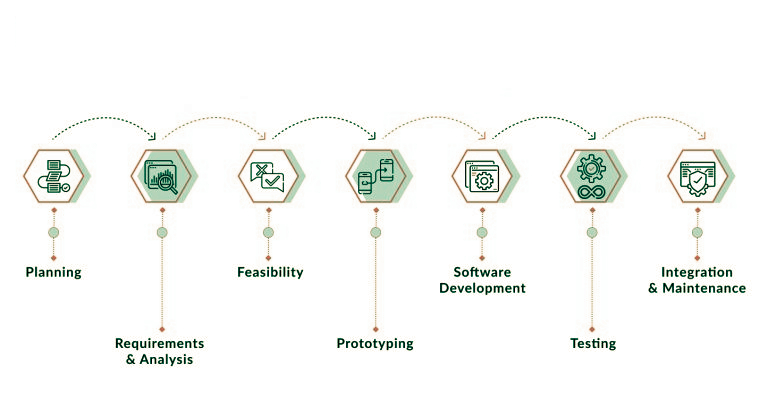
Things You Need to Know About Software Development Life Cycle
Developing a product, a team should choose the proper model of the development process. Since the process is a complex thing, choosing the right one impacts the team’s performance significantly. Nowadays, there are numerous SDLC models, and they fit different product goals. In this article, we will discuss the most popular ones and speak on their pros and cons, which may help you choose the best one for particular needs.
What is SDLC?
Software Development Life Cycle (SDLC) refers to complex methodologies that clarify and set software creation processes. Selecting a proper SDLC model is essential for the product’s quality. However, no general method would fit all requirements, and a model should be chosen by the professionals carefully depending on the product expectations, possible issues, and needs. The information listed below may help you understand how to select a model.
Seven main stages of SDLC processes
Any software development process always consists of the following stages:
- requirements analysis
- planning
- prototyping
- development
- testing
- deployment
- maintenance


Each stage requires a good specialist to perform it, and it is highly recommended to hire a team of experts and divide their tasks to achieve better results.
The most popular SDLC models
There are several most used SDLC models, and we will take a look at each of those to help you choose the approach you need.
Waterfall
The waterfall methodology is one of the earliest development models. Thus, it might be outdated but still widely used for projects requiring strict processes and guidelines. Its main idea is that the workflow should be sequential, and the progress should move to the next stage only when the previous one is perfectly done, which means that it is not possible to turn back to fix issues of the previous stage.
Thus, the methodology’s pros are:
- the processes are strictly structured;
- helps to schedule the product;
- it is simple to explain and plan;
- the guidelines are accurate and strict.
And its cons are:
- total lack of flexibility;
- it consumes money and time.
V-shaped model
This model is very similar to the previously mentioned Waterfall methodology. Same as Waterfall, the processes ‘move down’ from one to another, but more testing is involved. Let’s take a look at its pros and cons to comprehend whether it may be used for your project or not.
Pros:
- it is easy to perform;
- includes products verification at an early stage;
- starting with test impacts the results of every process.
Cons:
- it lacks flexibility;
- has no early prototypes;
- is money-consuming.
Agile
Agile is a category of methods rather than a separate one. Around 75% of modern projects use it. It is based on an iterative methodology based on tight communication between developers and end-users. The approach aims to deliver particular elements of the product to the clients quickly. Thus, it requires less documentation and more testing. We will discuss several Agile models, which are Kanban, Scrum, and Extreme Programming.
Kanban
The main feature that distinguishes the Kanban methodology is that iterations are mostly performed in brief daily sprints. Using the Kanban board, team members are provided with the necessary information about the project in general, its goals, current progress, and their responsibilities. The board also allows for prioritizing tasks. Another advantage of the Kanban system is that the customers may check the current product status whenever they want.
Scrum
Similar to Kanban, Scrum is based on iterative models and helps provide clear information about the project to the clients timely. Development with scrum is efficient, quick, and adjustable.
Extreme Programming (XP)
XP allows performing changes even when the iteration is launched since its iterations usually last up to two weeks. This kind of flexibility might make the development process complicated. However, this problem is solved with a pair of programming and test automation.
Incremental and iterative model
This model aims to overcome the disadvantages of the Waterfall approach, and its main idea is having a system of several cycles that constantly repeat themselves. This approach suits best for big projects that include several built-in parts or separate elements.
Pros:
- issues are easy to detect and solve due to fast changes;
- resources are used efficiently;
- focusing on end-users.
Cons:
- requires lots of documentation;
- it isn’t easy to divide functions;
- heavy emphasis on customer interaction which may lead the product in the wrong direction.
Spiral model
This model is used for large and expensive products. It sticks to many waterfall stages but separates them into the preparation and planning phase, risk evaluation, and simulations creation. It also uses a lot of testing and cycles repetition in order to improve each one of them. Thus, it best fits complicated projects with several goals and demands or for innovative projects requiring research.
Pros:
- precise budgeting and scheduling;
- great risk management;
- fits complex projects.
Cons:
- it is expensive;
- requires involving lots of specialists.
The Rational Unified Process
RUP is divided into four specific stages, which are inception, design, development, and transition. Each of those consists of several iterations and all activities are being completed at the time. Therefore, it is a good solution for risky products or top-notch software.
Conclusion
To pick an SDLC model, you should understand whether your project is big or small, simple or complex, and how big your budget is. Hiring experienced specialists is crucially vital for choosing a proper approach.



